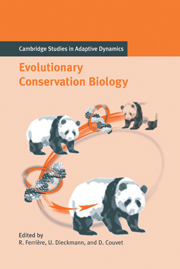Book contents
- Frontmatter
- Contents
- Contributing Authors
- Acknowledgments
- Notational Standards
- 1 Introduction
- Part A Theory of Extinction
- Part B The Pace of Adaptive Responses to Environmental Change
- Part C Genetic and Ecological Bases of Adaptive Responses
- Part D Spatial Structure
- 12 Genetic Structure in Heterogeneous Environments
- 13 Conservation Implications of Niche Conservatism and Evolution in Heterogeneous Environments
- 14 Adaptive Responses to Landscape Disturbances: Theory
- 15 Adaptive Responses to Landscape Disturbances: Empirical Evidence
- Part E Community Structure
- References
- Index
- The International Institute for Applied Systems Analysis
15 - Adaptive Responses to Landscape Disturbances: Empirical Evidence
Published online by Cambridge University Press: 15 August 2009
- Frontmatter
- Contents
- Contributing Authors
- Acknowledgments
- Notational Standards
- 1 Introduction
- Part A Theory of Extinction
- Part B The Pace of Adaptive Responses to Environmental Change
- Part C Genetic and Ecological Bases of Adaptive Responses
- Part D Spatial Structure
- 12 Genetic Structure in Heterogeneous Environments
- 13 Conservation Implications of Niche Conservatism and Evolution in Heterogeneous Environments
- 14 Adaptive Responses to Landscape Disturbances: Theory
- 15 Adaptive Responses to Landscape Disturbances: Empirical Evidence
- Part E Community Structure
- References
- Index
- The International Institute for Applied Systems Analysis
Summary
Introduction
Previous chapters of this book examine the risks of extinction for small and/or isolated populations. Here we try to analyze, from empirical data, how species and metapopulations can respond to habitat fragmentation. During the past 30 years, metapopulation biology has become recognized as an invaluable perspective in ecology, genetics, and evolution (Olivieri et al. 1990), and a considerable body of theoretical and empirical research has been carried out (for reviews see Harrison and Hastings 1996; Hanski and Gilpin 1997; Hanski 1999).
The abundance of a species depends not only on the availability of habitats that match the ecological requirements of the species, but also on the life-history characteristics that influence the persistence and colonization ability of the local population, that is its metapopulation dynamics (see Chapter 4). Colonization ability, in particular, is critical, and depends on traits related to migration and on the ability to establish a new population from a small propagule size (Box 15.1). Rapid colonization may compensate for a low probability of local persistence (e.g., Van der Meijden et al. 1985). Besides determining colonization abilities, migration also affects local population viability, especially when local population dynamics are greatly influenced by spatially uncorrelated stochasticity (e.g., Stacey and Taper 1992).
The evolved characters of populations, metapopulations, and species also depend on rates of gene flow among populations and on extinction–colonization dynamics (Olivieri et al. 1995; Storfer 1999).
- Type
- Chapter
- Information
- Evolutionary Conservation Biology , pp. 284 - 300Publisher: Cambridge University PressPrint publication year: 2004
- 6
- Cited by

